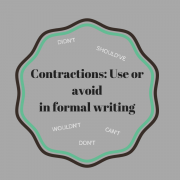Contractions: Use or avoid in formal writing?
Are contractions good or bad in formal writing?
I’ve had several clients whose style guidelines don’t allow the use of contractions. For my part, I didn’t believe in contractions at the start of my investment writing career. That’s what I’d learned in my high school English classes. I remember “fixing” all of the contractions in a portfolio manager’s commentary when I worked at Batterymarch Financial Management. However, I am now a fan of contractions.
Style guides for contractions
I found a statement against avoiding contractions in Dreyer’s English: An Utterly Correct Guide to Clarity and Style. Benjamin Dreyer says of the rule against contractions:
This may be a fine rule to observe if you learned English on your native Mars, but there’s not a goshdarn thing wrong with “don’t,” “can’t,” “wouldn’t,” and all the rest of them that people naturally use, and without them many a piece would turn out stilted and would turn out stilted and wooden… Contractions are why God invented the apostrophe, so make good use of both.
Bryan Garner agrees in Garner’s Modern American Usage. He says of contractions, “…why shouldn’t writers use them in most types of writing?”
Garner also says, “The common fear is that using contractions can make the writing seem breezy. For most of us, though, that risk is nil. What you gain should be a relaxed sincerity—not breeziness.” He cites several authorities on writing to support his opinion.
Style guides against contractions
The online AP Stylebook (subscription required) says, “Avoid excessive use of contractions. Contractions listed in the dictionary are acceptable, however, in informal contexts where they reflect the way a phrase commonly appears in speech or writing.”
The Grammar Bible says, “Contractions may be appropriate and expeditious in casual writing, but they are to be avoided in more formal documents.”
Both Dreyer and Garner warn against more casual contractions, such as “should’ve,” which Garner calls a “casualism.”
What do YOU think about contractions?
I’m sure you use contractions in your daily speech, and probably even in your blog posts. But what about a white paper? It depends on your firm’s style.
Disclosure: If you click on an Amazon link in this post and then buy something, I will receive a small commission. I link only to books in which I find some value for my blog’s readers.




I’m a professional Senior Technical Writer and I supervise the technical writing team at my company. I spent several years in scientific and technical publishing before becoming a technical editor for a large telecommunications company. I have been a technical writer for more than thirty years. I do not use contractions in formal writing, I remove all contractions from documents submitted by my subordinates, and I wrote the team style guide, in which I explicitly inveighed against the use of contractions (as well as against humor: technical writers are never as funny as they think they are and, eventually, what they commit to print as comedy is just embarrassing, like a tattoo on a great grandmother). Other signs of judgment that I forbid are use of the future tense and the use of possessive nouns.
Oddly enough, I am not very harsh about the passive voice. That’s because I am very sloppy with regard to passive voice and I own the style guide, so I get to do what I want. It’s good to be the king.
Dean,
Thank you for taking the time to comment!
Yes, it is good to be the king. I enjoy that with the monthly magazine that I edit.
I’m also a big believer in consistency. If your firm’s style guide says no contractions, then writers should write accordingly.